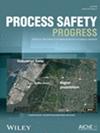诊断工业流程中的静电问题和危害:案例研究
IF 1
4区 工程技术
Q4 ENGINEERING, CHEMICAL
引用次数: 0
摘要
静电是一种经常遇到的现象,但就其潜在危害而言,却经常被误解和低估;它继续对工业流程的安全性和可靠性提出挑战,尤其是那些涉及易燃物质的流程。本文通过介绍两个闪燃/爆炸案例研究,深入探讨了工业环境中的静电危害这一关键问题,一个涉及联苯粉尘,另一个涉及汽油蒸气;两者都与静电放电有关。第一个案例研究探讨了联苯薄片生产过程中焙烧炉和包装出料斗发生的爆炸。调查揭示了静电荷在事故中的作用,以及用心良苦的设备改动是如何造成风险增加的警告信号却被忽视的。第二个案例研究讨论了一起汽油蒸汽闪燃火灾,强调了在易燃液体转移过程中常见但却被忽视的静电危险。它强调了涉及人员的普通活动是如何产生足够的静电电荷来点燃工业中的易燃蒸汽-空气混合物的。这些研究成果强调了对静电早期预警信号采取行动的重要性,以及数据驱动诊断技术在应对和控制这些危害方面的关键作用。通过剖析错综复杂的静电现象,安全专业人员可以制定可行的策略,以调整工厂运营并预防静电危害。该论文提倡采取积极主动的方法来识别和降低工业环境中的静电风险,首先进行工艺危害分析,将静电危害分析纳入其中,然后通过员工培训来确保识别、理解早期预警信号并采取相应措施。它强调了采取全面安全措施的必要性,包括正确接地和接合、使用静电消散材料和定期维护安全设备,以防止事故发生。通过这些案例研究,本文有助于人们了解工业流程中的静电危害,并强调了将静电安全措施纳入常规工业操作的重要性。本文章由计算机程序翻译,如有差异,请以英文原文为准。
Diagnosing electrostatic problems and hazards in industrial processes: Case studies
Static electricity is a phenomenon commonly encountered yet often misunderstood and underestimated in terms of its hazard potential; it continues to challenge the safety and reliability of industrial processes, particularly those involving flammable substances. This paper delves into the critical issue of electrostatic hazards in industrial settings by presenting two flash fire/explosion case studies, one involving biphenyl dust and the other gasoline vapor; both linked to electrostatic discharges. The first case study examines an explosion in a flaker and pack‐out hopper during biphenyl flake manufacturing. The investigation reveals the role of electrostatic charges in the incident and how well‐intentioned equipment changes created warning signs of increased risk that were missed. The second case study discusses a gasoline vapor flash fire, highlighting the common yet overlooked hazard of static electricity during the transfer of flammable liquids. It underscores how common activities involving people can generate sufficient electrostatic charge to ignite flammable vapor–air mixtures in industry. The outcomes of these studies highlight the importance of acting on early warning signs of static electricity and the crucial role of data‐driven diagnostic techniques in addressing and controlling those hazards. By dissecting the intricacies of electrostatic phenomena, safety professionals can formulate actionable strategies to adapt plant operations and prevent hazards from static electricity. The paper advocates for a proactive approach to identifying and mitigating electrostatic risks in industrial settings beginning with process hazard analyses that incorporate static electricity hazards analysis and continues through employee training to ensure that early warning signs are identified, understood, and acted upon. It stresses the need for comprehensive safety measures, including proper grounding and bonding, use of static dissipative materials, and regular maintenance of safety equipment, to prevent incidents. Through these case studies, the paper contributes to understanding of electrostatic hazards in industrial processes and highlights the importance of integrating electrostatic safety measures into routine industrial operations.
求助全文
通过发布文献求助,成功后即可免费获取论文全文。
去求助
来源期刊

Process Safety Progress
工程技术-工程:化工
CiteScore
2.20
自引率
10.00%
发文量
99
审稿时长
6-12 weeks
期刊介绍:
Process Safety Progress covers process safety for engineering professionals. It addresses such topics as incident investigations/case histories, hazardous chemicals management, hazardous leaks prevention, risk assessment, process hazards evaluation, industrial hygiene, fire and explosion analysis, preventive maintenance, vapor cloud dispersion, and regulatory compliance, training, education, and other areas in process safety and loss prevention, including emerging concerns like plant and/or process security. Papers from the annual Loss Prevention Symposium and other AIChE safety conferences are automatically considered for publication, but unsolicited papers, particularly those addressing process safety issues in emerging technologies and industries are encouraged and evaluated equally.
 求助内容:
求助内容: 应助结果提醒方式:
应助结果提醒方式:


